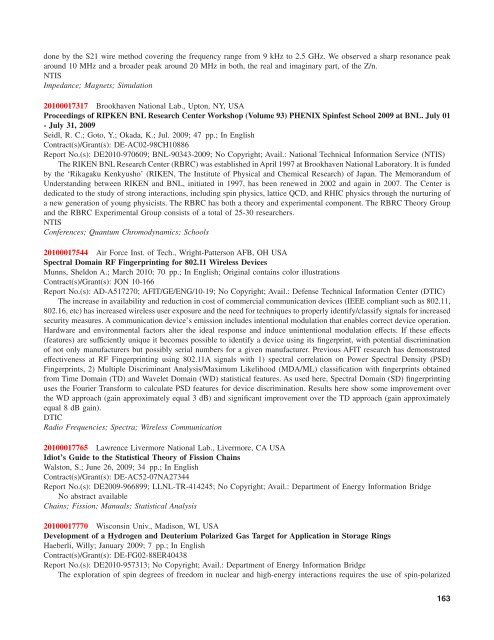NASA Scientific and Technical Aerospace Reports - The University ...
NASA Scientific and Technical Aerospace Reports - The University ...
NASA Scientific and Technical Aerospace Reports - The University ...
Create successful ePaper yourself
Turn your PDF publications into a flip-book with our unique Google optimized e-Paper software.
done by the S21 wire method covering the frequency range from 9 kHz to 2.5 GHz. We observed a sharp resonance peak<br />
around 10 MHz <strong>and</strong> a broader peak around 20 MHz in both, the real <strong>and</strong> imaginary part, of the Z/n.<br />
NTIS<br />
Impedance; Magnets; Simulation<br />
20100017317 Brookhaven National Lab., Upton, NY, USA<br />
Proceedings of RIPKEN BNL Research Center Workshop (Volume 93) PHENIX Spinfest School 2009 at BNL. July 01<br />
- July 31, 2009<br />
Seidl, R. C.; Goto, Y.; Okada, K.; Jul. 2009; 47 pp.; In English<br />
Contract(s)/Grant(s): DE-AC02-98CH10886<br />
Report No.(s): DE2010-970609; BNL-90343-2009; No Copyright; Avail.: National <strong>Technical</strong> Information Service (NTIS)<br />
<strong>The</strong> RIKEN BNL Research Center (RBRC) was established in April 1997 at Brookhaven National Laboratory. It is funded<br />
by the ‘Rikagaku Kenkyusho’ (RIKEN, <strong>The</strong> Institute of Physical <strong>and</strong> Chemical Research) of Japan. <strong>The</strong> Memor<strong>and</strong>um of<br />
Underst<strong>and</strong>ing between RIKEN <strong>and</strong> BNL, initiated in 1997, has been renewed in 2002 <strong>and</strong> again in 2007. <strong>The</strong> Center is<br />
dedicated to the study of strong interactions, including spin physics, lattice QCD, <strong>and</strong> RHIC physics through the nurturing of<br />
a new generation of young physicists. <strong>The</strong> RBRC has both a theory <strong>and</strong> experimental component. <strong>The</strong> RBRC <strong>The</strong>ory Group<br />
<strong>and</strong> the RBRC Experimental Group consists of a total of 25-30 researchers.<br />
NTIS<br />
Conferences; Quantum Chromodynamics; Schools<br />
20100017544 Air Force Inst. of Tech., Wright-Patterson AFB, OH USA<br />
Spectral Domain RF Fingerprinting for 802.11 Wireless Devices<br />
Munns, Sheldon A.; March 2010; 70 pp.; In English; Original contains color illustrations<br />
Contract(s)/Grant(s): JON 10-166<br />
Report No.(s): AD-A517270; AFIT/GE/ENG/10-19; No Copyright; Avail.: Defense <strong>Technical</strong> Information Center (DTIC)<br />
<strong>The</strong> increase in availability <strong>and</strong> reduction in cost of commercial communication devices (IEEE compliant such as 802.11,<br />
802.16, etc) has increased wireless user exposure <strong>and</strong> the need for techniques to properly identify/classify signals for increased<br />
security measures. A communication device’s emission includes intentional modulation that enables correct device operation.<br />
Hardware <strong>and</strong> environmental factors alter the ideal response <strong>and</strong> induce unintentional modulation effects. If these effects<br />
(features) are sufficiently unique it becomes possible to identify a device using its fingerprint, with potential discrimination<br />
of not only manufacturers but possibly serial numbers for a given manufacturer. Previous AFIT research has demonstrated<br />
effectiveness at RF Fingerprinting using 802.11A signals with 1) spectral correlation on Power Spectral Density (PSD)<br />
Fingerprints, 2) Multiple Discriminant Analysis/Maximum Likelihood (MDA/ML) classification with fingerprints obtained<br />
from Time Domain (TD) <strong>and</strong> Wavelet Domain (WD) statistical features. As used here, Spectral Domain (SD) fingerprinting<br />
uses the Fourier Transform to calculate PSD features for device discrimination. Results here show some improvement over<br />
the WD approach (gain approximately equal 3 dB) <strong>and</strong> significant improvement over the TD approach (gain approximately<br />
equal 8 dB gain).<br />
DTIC<br />
Radio Frequencies; Spectra; Wireless Communication<br />
20100017765 Lawrence Livermore National Lab., Livermore, CA USA<br />
Idiot’s Guide to the Statistical <strong>The</strong>ory of Fission Chains<br />
Walston, S.; June 26, 2009; 34 pp.; In English<br />
Contract(s)/Grant(s): DE-AC52-07NA27344<br />
Report No.(s): DE2009-966899; LLNL-TR-414245; No Copyright; Avail.: Department of Energy Information Bridge<br />
No abstract available<br />
Chains; Fission; Manuals; Statistical Analysis<br />
20100017770 Wisconsin Univ., Madison, WI, USA<br />
Development of a Hydrogen <strong>and</strong> Deuterium Polarized Gas Target for Application in Storage Rings<br />
Haeberli, Willy; January 2009; 7 pp.; In English<br />
Contract(s)/Grant(s): DE-FG02-88ER40438<br />
Report No.(s): DE2010-957313; No Copyright; Avail.: Department of Energy Information Bridge<br />
<strong>The</strong> exploration of spin degrees of freedom in nuclear <strong>and</strong> high-energy interactions requires the use of spin-polarized<br />
163

















